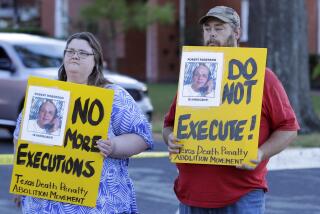Governor, let Tookie live
In deciding whether Stanley Tookie Williams should die Dec. 13 for murdering four people, Gov. Arnold Schwarzenegger’s unenviable task is to play God. The question he must answer is whether Williams’ reformation during the last 16 years is sufficient to let him live out his life in prison.
The “old Tookie,” circa 1979, shot 7-Eleven employee Albert Owens in the back of the head, execution-style, during a robbery. Two weeks later, he murdered three members of the Yang family while robbing their motel business.
Then there is the “new Tookie,” circa 1989 to the present. Returning to death row after more than six years of solitary confinement, Williams wrote children’s books advocating nonviolence and alternatives to gangs, and an autobiography. In 2004, he helped broker a peace agreement, known as the Tookie Protocol for Peace, to end one of the deadliest gang wars in the country. He has been nominated for the Nobel Peace Prize multiple times.
The law is silent on which Williams the governor should judge, though the long appellate process has morphed a murderer into a peacemaker. But Schwarzenegger can look to the law to make a decision.
The governor has twice considered — and twice denied — clemency for death row inmates. The Williams case is complicated because his accomplishments are dramatic and their effects measurable.
Jonathan Harris, a lawyer working for Williams, asks: If he is not granted clemency based on his personal redemption and the thousands of people he has positively touched, who would you give it to?
Although affirming Williams’ conviction and death sentence, the U.S. 9th Circuit Court of Appeals took the unprecedented step of urging the governor to seriously consider a clemency petition from Williams.
The state’s district attorneys, victims rights groups, sheriffs and police chiefs demand that Williams be executed for what a jury said he did: the murder of four people, for which the jury set the penalty as death, not life without parole.
Schwarzenegger should reweigh the penalty-phase evidence based on what is known about Williams now, as opposed to then.
A death penalty case is divided into the guilt phase and the penalty phase. In finding Williams guilty of four murders, a jury determined that he would receive either a sentence of death or life in prison without the possibility of parole.
In the penalty phase, the jury recommends a sentence. I have argued eight death-penalty phases, and there is nothing in law more weighty and terrifying than pleading for a man’s life. My opening statement is always the same:
“Ladies and gentlemen of the jury, you have already determined by your guilt-phase verdict that my client will die in prison and be buried in an unmarked pauper’s grave outside the prison’s gates. The only remaining question is whether the defendant’s death should occur at a time chosen by God, or a time chosen by you.”
The evidence presented during the penalty phase is unique in law. The prosecution offers evidence of aggravating factors — why the jury should order the defendant put to death — and the defense puts forth evidence of mitigating factors — why the jury should decide in favor of life without parole. The question for the jury is often whether the defendant’s life has any redeeming worth: Has this guy done anything that warrants keeping him alive?
Williams was represented by attorney Joe Ingber, my co-counsel in my first death-penalty case in 1984.
Ingber offered no mitigating evidence at Williams’ penalty-phase trial. The California Supreme Court, U.S. District Judge Stephen V. Wilson and the 9th Circuit Court of Appeals determined that Ingber performed competently in choosing not to mount a penalty-phase defense, one suspects, because there was not much of one to present.
Schwarzenegger should seriously consider the mitigating evidence that has arisen since Williams was sentenced to death. If Ingber could have presented evidence that Williams would be nominated for the Nobel Peace Prize multiple times, that he would write anti-gang children’s books and negotiate the end to a gang war, it is reasonable to believe that the jury might have found sufficient value in Williams’ life to spare him death.
The controversy over Williams’ execution echoes that of rapist Caryl Chessman in 1960. Chessman wrote four popular books about his conviction and imprisonment while on death row. Students in Lisbon, Portugal, rioted in protest of one of his eventual nine execution dates. It is commonly thought that then-Gov. Pat Brown suffered politically when he refused to stay Chessman’s execution in 1960. Brown defeated Richard Nixon in 1962 to win a second term.
Still, to his death, Brown, a former district attorney and attorney general, felt that his refusal to ignore politics and commute Chessman’s sentence to life in prison was his greatest personal failure.
More to Read
Sign up for Essential California
The most important California stories and recommendations in your inbox every morning.
You may occasionally receive promotional content from the Los Angeles Times.










